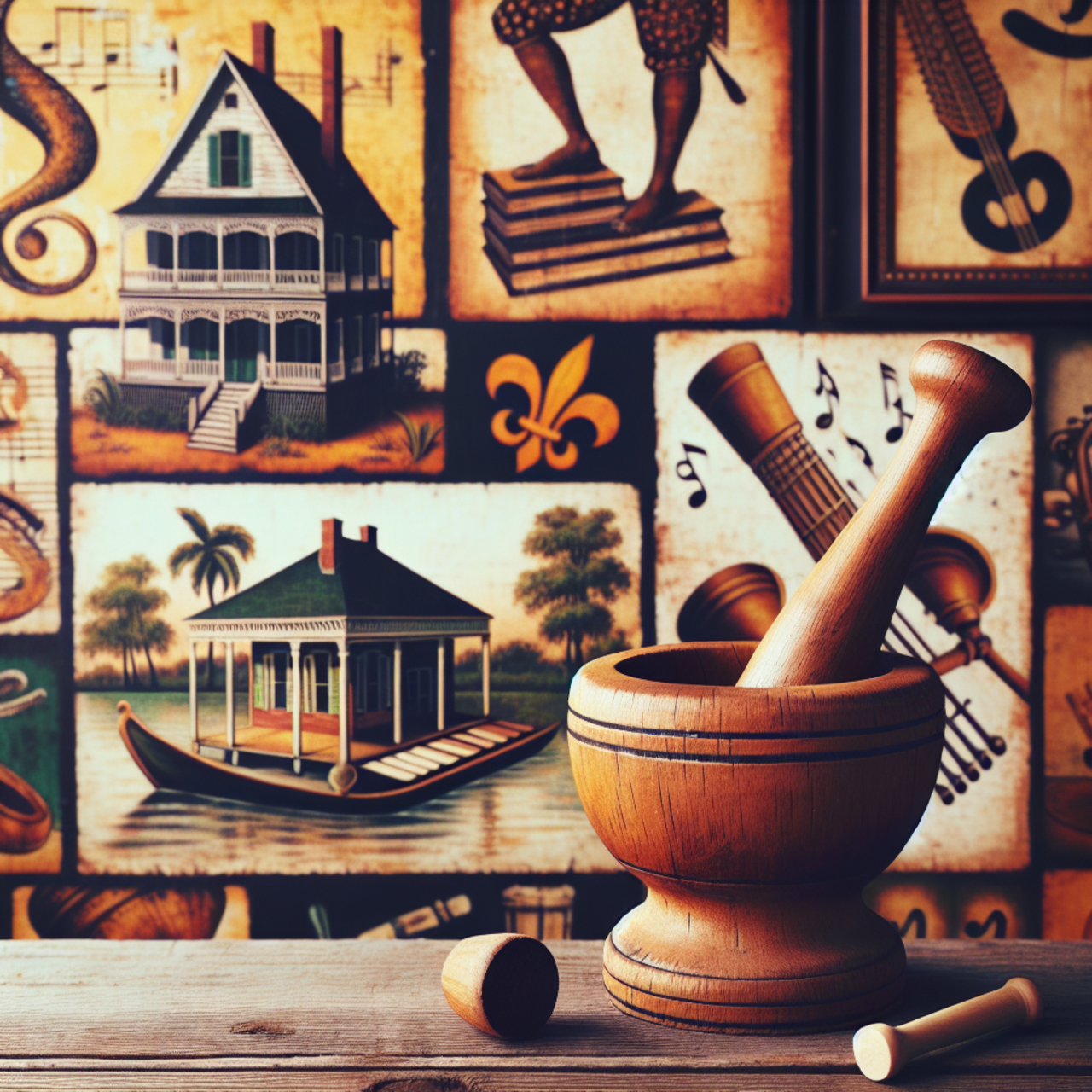We came for the armoires, but I left thinking about ground cornmeal. Each year, the Historic New Orleans Collection’s Decorative Arts of the Gulf South (DAGS) program sends a team of interns to document and catalog the material culture of historic sites. Interns learn how to identify, photograph, and describe historic objects in public and private collections. On this particular day, we were doing fieldwork near Lafayette, Louisiana, in a home filled with 19th-century cherry and cypress furniture. Curiously, it was during a pause in our work, just as we put down the camera and laptop for a break in the kitchen, that we noticed a cylindrical trunk of hollowed cypress. Standing in it were iron racks, a bread paddle, and various poles, including something resembling an oversized wooden cotton swab. My mind still in a cloud of armoires, I suddenly registered an oversized mortar and pestle.
Everyday household objects like the mortar and pestle have a way of hiding in plain sight. They can escape attention precisely because they are so commonplace. The same can hold true in historic preservation—we preserve what we prize while time parts us from the rest. As Jack Holden observes in *Furnishing Louisiana*, “utilitarian objects are often the first to be discarded . . . as a result, these functional—if underappreciated—artifacts are rare survivors.”
For millennia, humans relied on the mortar and pestle to crush and grind the cereals they needed to survive. Before the advent of industrial mechanization, manually separating the hard external shell from kernels of rice or corn to make bread, beer, or animal feed was a daily task often done by groups of women. Because it could be grueling and monotonous work, using the mortar and pestle became the province of people at the lowest rungs of colonial society in North America: indentured and, especially, enslaved people. Enslaved women of African descent carried their cultural knowledge of rice preparation, which involved using a mortar and pestle to dehull the grains, to American shores from South Carolina to Louisiana. The native peoples they met, including the Choctaw, similarly used a mortar (“kitti”) and pestle (“kittush”) to grind maize and hominy into cornmeal.
Back in the kitchen near Lafayette, our host referred to the mortar and pestle as a “pilé” and “pilon” from the Koasati (Coushatta) settlement near Elton, Louisiana. Both were hand-hewn cypress. The pilé was reinforced at the base; the pilon, with heavier, rounded ends, was tapered in the middle for an easy grip. Preservation efforts are understandably drawn towards the exceptional or pristine, but it was the utilitarian nature of the pilé and pilon that appealed to me—the dulled and worn grooves of the bowl and the roughly scored ends of the pilon signaled plenty of use. How many generations of people used it? I wondered how much cornmeal I might crush in a day. Would it taste any better because I did it myself? Just how long have objects like these been used in Louisiana?
Records from the 18th century date the daily pounding of rice and corn by enslaved Africans to the 1720s, but no large mortars and pestles from French colonial settlements are known to have survived. Some examples of mortars and pestles used by Indigenous people in the region, who used them long before the French established their first settlements along the Gulf Coast, still survive, especially in the Cane River corridor at sites like Oakland and Melrose plantations. John Oswald Colson, a Cane River Creole and culture bearer known as the “Filé Man,” draws from traditional Creole Indigenous foodways in his annual demonstrations of the traditional preparation of filé seasoning. Pounding sassafras leaves in a pilé and pilon hand-crafted by Koasati elder Bel Abbey, Colson links together family, kinship, and land ties.
The pilé and pilon sitting back in our host’s Lafayette-area kitchen, it turns out, share the same Koasati origin as the pair used by Colson. Like Colson’s, these utilitarian objects take on additional meaning for precisely the same reasons that they are likely to be seen as unimportant—because they are so well used. The more useful and ordinary an object is, the more used it is, the more likely it is to be damaged, discarded, or forgotten, and the less likely it is to be preserved by professionals. But as John Oswald Colson’s traditional embrace of the pilé and pilon demonstrates, it was and is the use of the mortar and pestle—both to prepare the evening’s meal and to encounter the tradition of one’s ancestors—that is perhaps the best preservation we have. Shared use gives continuity to cultural practice. To use or shape with the tool is to be shaped by it in turn.
The story of the pilé and pilon I came across near Lafayette started in the break room, in the margins of a story about armoires. But something I’ve come to appreciate about storytelling and material culture during my time with the DAGS program is the way an object can help train you to distinguish between what you’re looking for and what’s right in front of you.



